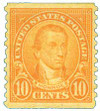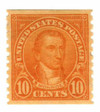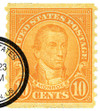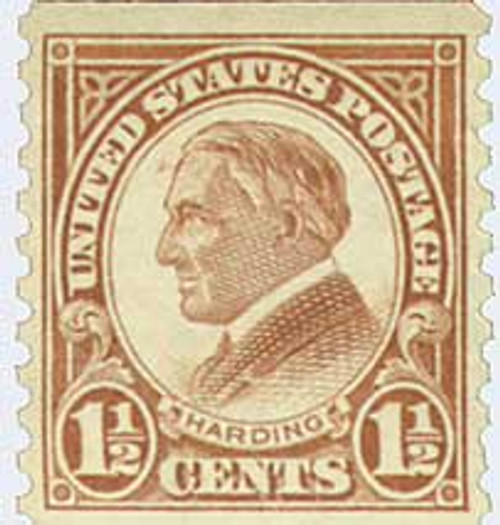
1924 10c Monroe, orange, coil
# 603 - 1924 10c Monroe, orange, coil
$0.70 - $29.00
U.S. #603
Series of 1923-26 10¢ James Monroe
Series of 1923-26 10¢ James Monroe
Issue Date: December 1, 1924
First City: Washington, D.C.
Quantity Issued: Unknown
Printed by: Bureau of Engraving and Printing
Printing Method: Rotary Press
Perforation: 10 vertically
Color: Orange
First City: Washington, D.C.
Quantity Issued: Unknown
Printed by: Bureau of Engraving and Printing
Printing Method: Rotary Press
Perforation: 10 vertically
Color: Orange
U.S. #603 was the last of the Series of 1923-26 to be issued. There wasn’t a great demand for the stamp, as large quantities of a previously issued 10¢ denomination were still available by the time U.S. #603 was produced. The 10¢ fee paid for both registered mail and special delivery rates.
James Monroe Sets the Course for American Foreign Policy
Pictured on U.S. #603, James Monroe’s two terms as President are referred to as “The Era of Good Feelings.” His kind and honest demeanor made him popular with the voters, and his dedication to uniting and protecting America led to his nearly unanimous re-election. With an administration highlighted by the “Missouri Compromise” and the “Monroe Doctrine,” James Monroe led America into a new era of unity and freedom from foreign disturbances.
Following hostilities with Spain and France, Monroe took a stand against foreign control in American territories. On December 2, 1823, in his annual address to Congress, President Monroe pronounced that “...We owe it, therefore, to candor and to the amicable relations existing between the United States and those powers to declare that we should consider any attempt on their part to extend their system to any portion of this hemisphere as dangerous to our peace and safety. With the existing colonies or dependencies of any European power we have not interfered and shall not interfere.”
This speech, which would later be known as the Monroe Doctrine, became the cornerstone of American foreign policy for over 100 years.
U.S. #603
Series of 1923-26 10¢ James Monroe
Series of 1923-26 10¢ James Monroe
Issue Date: December 1, 1924
First City: Washington, D.C.
Quantity Issued: Unknown
Printed by: Bureau of Engraving and Printing
Printing Method: Rotary Press
Perforation: 10 vertically
Color: Orange
First City: Washington, D.C.
Quantity Issued: Unknown
Printed by: Bureau of Engraving and Printing
Printing Method: Rotary Press
Perforation: 10 vertically
Color: Orange
U.S. #603 was the last of the Series of 1923-26 to be issued. There wasn’t a great demand for the stamp, as large quantities of a previously issued 10¢ denomination were still available by the time U.S. #603 was produced. The 10¢ fee paid for both registered mail and special delivery rates.
James Monroe Sets the Course for American Foreign Policy
Pictured on U.S. #603, James Monroe’s two terms as President are referred to as “The Era of Good Feelings.” His kind and honest demeanor made him popular with the voters, and his dedication to uniting and protecting America led to his nearly unanimous re-election. With an administration highlighted by the “Missouri Compromise” and the “Monroe Doctrine,” James Monroe led America into a new era of unity and freedom from foreign disturbances.
Following hostilities with Spain and France, Monroe took a stand against foreign control in American territories. On December 2, 1823, in his annual address to Congress, President Monroe pronounced that “...We owe it, therefore, to candor and to the amicable relations existing between the United States and those powers to declare that we should consider any attempt on their part to extend their system to any portion of this hemisphere as dangerous to our peace and safety. With the existing colonies or dependencies of any European power we have not interfered and shall not interfere.”
This speech, which would later be known as the Monroe Doctrine, became the cornerstone of American foreign policy for over 100 years.




















